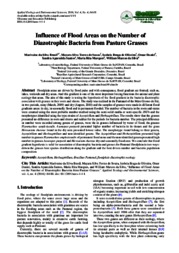Influence of flood areas on the number of diazotrophic bacteria from pasture grasses.
Influence of flood areas on the number of diazotrophic bacteria from pasture grasses.
Autoria: BRASIL, M. da S.; SOUZA, M. S. T. de; OLIVEIRA, I. B. de; DANIEL, O.; SANTOS, S. A.; MARQUES, M. R.; SILVA, W. M. da
Resumo: Floodplain areas are driven by flood pulse and with consequence, flood gradient are formed, such as, lakes, wetlands and dry areas. And this gradient is one of the most important forcing functions for animal and plant ecology that areas. The aim of this study is testing the hypothesis of the flood gradient in the bacteria diazotrophic association with grasses in their roots and shoots. The study was realized in the Pantanal of the Mato Grosso do Sul, in two periods, rainy (March, 2009) and dry (August, 2010) and the samples of grasses were made in different flood gradients areas: in dry, in seasonally flood and in permanent flooded. The number of bacteria in the roots and stems were counted using the most probable number method using the semi-solid media or semi-specific JNFb and the morphotypes identified using the type strains of Azospirillum and Herbaspirillum. The results show that the grasses presented no difference in roots and shoots and neither for the periods for bacteria number. The principal difference in number were recorded among genera of grasses, were the in grasses influenced by water of flood, the grasses Hymenachne amplexicaulis, Axonopus purpusii presented higher number of bacteria in its tissues and the grass Mesosetum chaseae found in the dry area presented lowest value. The morphotype found belong to three genera, Azospirillum and Herbaspirillum and non-identified genera. The Azospirillum and Herbaspirillum presented high number in grasses Hymenachne amplexicaulis of permanent flood areas and the non-identified genera presented high number in grasses Axonopus purpusii and Mesosetum chaseae dry and seasonally flood area. We conclude that flood gradient hypothesis is valid for association of diazotrophic bacteria and grasses for Pantanal floodplain in two ways: driven the grasses host species distribution along the gradient and the host driven number and bacteria population composition.
Ano de publicação: 2016
Tipo de publicação: Artigo de periódico
Unidade: Embrapa Pantanal
Palavras-chave: Flood, Floodplain, Graminea, Grasses, Inundacao
Observações
1 - Por padrão são exibidas publicações dos últimos 20 anos. Para encontrar publicações mais antigas, configure o filtro ano de publicação, colocando o ano a partir do qual você deseja encontrar publicações. O filtro está na coluna da esquerda na busca acima.
2 - Para ler algumas publicações da Embrapa (apenas as que estão em formato ePub), é necessário ter, no celular ou computador, um desses softwares gratuitos. Sistemas Android: Google Play Livros; IOS: iBooks; Windows e Linux: software Calibre.
Acesse outras publicações
Acesse a Base de Dados da Pesquisa Agropecuária (BDPA) para consultar o acervo completo das bibliotecas da Embrapa.

